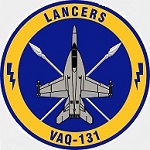Hobby Master HA5153 US Navy Boeing E/A-18G Growler Electronic Warfare Aircraft - 168772, VAQ-131 "The Lancers", Operation Inherent Resolve, 2019 (1:72 Scale)
"The tip of the she spear"
- Motto of VAQ-131 "The Lancers"
 The Boeing EA-18G Growler is an American carrier-based electronic warfare aircraft, a specialized version of the two-seat F/A-18F Super Hornet. The EA-18G replaced the Northrop Grumman EA-6B Prowlers in service with the United States Navy. The Growler's electronic warfare capability is primarily provided by Northrop Grumman. The EA-18G began production in 2007 and entered operational service with the US Navy in late 2009. Australia has also purchased twelve EA-18Gs, which entered service with the Royal Australian Air Force in 2017.
The Boeing EA-18G Growler is an American carrier-based electronic warfare aircraft, a specialized version of the two-seat F/A-18F Super Hornet. The EA-18G replaced the Northrop Grumman EA-6B Prowlers in service with the United States Navy. The Growler's electronic warfare capability is primarily provided by Northrop Grumman. The EA-18G began production in 2007 and entered operational service with the US Navy in late 2009. Australia has also purchased twelve EA-18Gs, which entered service with the Royal Australian Air Force in 2017.
On November 15th, 2001, Boeing successfully completed an initial flight demonstration of F/A-18F "F-1" fitted with the ALQ-99 electronic warfare system to serve as the EA-18 Airborne Electronic Attack (AEA) concept aircraft. In December 2003, the US Navy awarded a development contract for the EA-18G to Boeing. As primary contractor, Boeing was to construct the forward fuselage, wings and perform the final assembly. Northrop Grumman was the principal air frame subcontractor and they would supply the center and aft fuselage as well as the principal electronic combat system. In 2003, the Navy expected to receive 90 EA-18Gs.
The first EA-18G test aircraft entered production on October 22nd, 2004. The first test aircraft, known as EA-1, was rolled out on August 3rd, 2006, before making its maiden flight at St. Louis on August 15th, 2006; it was later ferried to Naval Air Station Patuxent River, Maryland on 22 September 2006. EA-1 primarily supports ground testing in the Air Combat Environment Test and Evaluation Facility (ACETEF) anechoic chamber.
The second aircraft (EA-2) first flew on November 10th, 2006, and was delivered to NAS Patuxent River on November 29th, 2006. EA-2 is an AEA flight test aircraft, initially flying on Pax River's Atlantic Test Range (ATR) for developmental test of the AEA system before transitioning to the Electronic Combat Range (ECR, or 'Echo Range') in Naval Air Weapons Station China Lake in California. Both aircraft are assigned to VX-23 "Salty Dogs". EA-1 and EA-2 are F/A-18Fs F-134 and F-135, pulled from the St. Louis production line and modified by Boeing to the EA-18G configuration. However, since they were not built initially as Growlers, the Navy has designated these two test aircraft as NEA-18Gs. There were five Growlers flying in the flight test program as of June 2008
Pictured here is a gorgeous 1:72 scale diecast replica of a US Navy Boeing E/A-18G Growler Electronic Warfare Aircraft that was attached to VAQ-131 "The Lancers", then participating in Operation Inherent Resolve during 2019.
Sold Out!
Dimensions:
Wingspan: 7-1/2-inches
Length: 9-inches
Release Date: April 2021
 Historical Account: "Operation Inherent Resolve" - Operation Inherent Resolve (OIR) is the U.S. military's operational name for the military intervention against the Islamic State of Iraq and Syria (ISIL, in the vernacular, Daesh), including both the campaign in Iraq and the campaign in Syria. Since August 21st, 2016, the U.S. Army's XVIII Airborne Corps has been responsible for Combined Joint Task Force - Operation Inherent Resolve (CJTF-OIR). The campaign is primarily waged by American air forces in support of local allies, most prominently the Iraqi security forces and Syrian Democratic Forces. Combat ground troops, mostly special forces and artillery, have also been deployed, especially in Iraq. 75-80% of the airstrikes have been conducted by the military of the United States, with the other 20-25% by the United Kingdom, France, Turkey, Canada, the Netherlands, Denmark, Belgium, Saudi Arabia, the United Arab Emirates, and Jordan.
Historical Account: "Operation Inherent Resolve" - Operation Inherent Resolve (OIR) is the U.S. military's operational name for the military intervention against the Islamic State of Iraq and Syria (ISIL, in the vernacular, Daesh), including both the campaign in Iraq and the campaign in Syria. Since August 21st, 2016, the U.S. Army's XVIII Airborne Corps has been responsible for Combined Joint Task Force - Operation Inherent Resolve (CJTF-OIR). The campaign is primarily waged by American air forces in support of local allies, most prominently the Iraqi security forces and Syrian Democratic Forces. Combat ground troops, mostly special forces and artillery, have also been deployed, especially in Iraq. 75-80% of the airstrikes have been conducted by the military of the United States, with the other 20-25% by the United Kingdom, France, Turkey, Canada, the Netherlands, Denmark, Belgium, Saudi Arabia, the United Arab Emirates, and Jordan.
According to the Pentagon, by March 23rd, 2019, the day of ISIL's territorial defeat in Syria, CJTF-OIR and partner forces had liberated nearly 110,000 square kilometers (42,471 square miles) of land and 7.7 million people from ISIL, the vast majority of the self-proclaimed caliphate's territory and subjects. By October 2017, around the time of ISIL's territorial defeat in Iraq, CJTF-OIR claimed that around 80,000 ISIL militants had been killed in all actions excluding those targeted by Russian and Syrian strikes. At that time of that statement, the coalition had conducted 28,198 strikes, and by the end of August 2019 it had conducted 34,573 strikes. Tens of thousands more were killed by partner forces on the ground (the Syrian Democratic Forces alone claimed to have killed 25,336 ISIL fighters by the end of 2017).







![USMC Lockheed-Martin F-35B Lightning II Joint Strike Fighter - VMFAT-501 "Warlords", Eglin AFB, Florida, 2014 [Low-Vis Scheme] (1:72 Scale)](http://cdn4.volusion.store/qh9e9-jdqv9/v/vspfiles/photos/HA4606-1.jpg?v-cache=1740197136)
